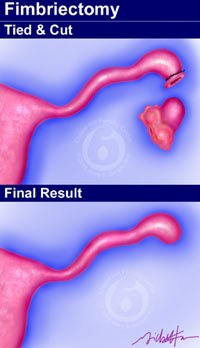Tubal Ligation by Fimbriectomy
 Fimbriectomy is an infrequent type of tubal ligation in the United States. This female sterilization method is performed by removing the fimbrial end of the fallopian tube. At the fimbrial end of the tube, the inner tubal lining faces outward towards the ovary. The tubal lining is rich in cilia that beat in coordinated waves to pull the egg into the tubal opening.
Fimbriectomy is an infrequent type of tubal ligation in the United States. This female sterilization method is performed by removing the fimbrial end of the fallopian tube. At the fimbrial end of the tube, the inner tubal lining faces outward towards the ovary. The tubal lining is rich in cilia that beat in coordinated waves to pull the egg into the tubal opening.
Many doctors think that tubal reversal cannot be successful following a fimbriectomy because of the loss of the egg-capturing fimbria. This is a mistaken notion. Cilia are abundant in the ampullary segment of the fallopian tube. The inner lining of the remaining ampullary tubal segment can be folded outward after opening the tube and can function as a new fimbrial end. The tubal reversal procedure for fimbriectomy reversal is called ampullary salpingostomy.
Fimbriectomy Reversal Pregnancy Rates
A Personal Choice publishes statistics updated annually regarding pregnancy rates and pregnancy outcomes for all of the women who have had tubal reversal procedures performed by Dr. Berger. The data for women who had tubal ligation procedures by fimbriectomy are from our Tubal Reversal Pregnancy Study Report 2007.
The overall pregnancy rate after fimbriectomy tubal reversal is 56% for patients at A Personal Choice. The following table shows the numbers and pregnancy rates according to womens’ ages at the time of their tubal reversal procedure.
Pregnancy Rates After Fimbriectomy Reversal
|
|
|
|
|
|
<30 |
29 |
20 |
69% |
|
30-34 |
82 |
52 |
63% |
|
35-39 |
131 |
81 |
62% |
|
40+ |
70 |
22 |
31% |
Recommendations for Fimbriectomy Reversal
The success of fimbriectomy reversal depends upon having an adequate length of ampullary segment of the fallopian tube. The length of the remaining ampullary tubal segment can be determined from a hysterosalpingogram (HSG) or from diagnostic laparoscopy.
I recommend having an HSG or choosing the screening laparoscopy option when tubal ligation has been performed by fimbriectomy. An HSG can be ordered by the patient’s local doctor and the x-ray films sent to me for examination prior to scheduling tubal reversal surgery. Alternatively, patients can omit having an HSG and schedule their reversal surgery to start with screening laparoscopy. This will show if ampullary salpingostomy will be effective. If so, the tubal reversal procedure will be performed at the same time while the patient is under anesthesia.









